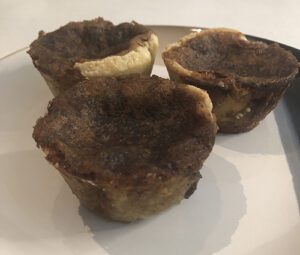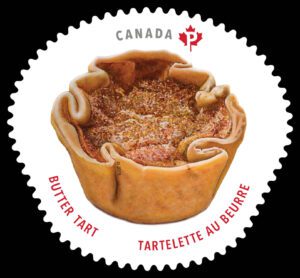Emma Minato
Watch our Education Coordinator try to make these tarts:
 When the days grow short and the holiday season approaches, the smell of fresh baking often wafts throughout homes. It is so warm and inviting compared to the cold winter weather outside. Amongst the holiday cookies, butter tarts are sure to make an appearance – at least in my family home it is almost guaranteed!
When the days grow short and the holiday season approaches, the smell of fresh baking often wafts throughout homes. It is so warm and inviting compared to the cold winter weather outside. Amongst the holiday cookies, butter tarts are sure to make an appearance – at least in my family home it is almost guaranteed!
To my surprise, the definition of these sweet treats come with a bit of debate and controversy. While most can agree that butter tarts are a pastry with a filling typically made of sugar, butter, syrup and eggs, what makes a ‘true’ butter tart is highly debated. Some believe that butter tarts must have raisins in the filling, whereas others would argue that no raisins are the proper way. Similarly, there are arguments that nuts should be thrown into the mix, however then we are treading the line with pecan pie. And as if there wasn’t enough debate, there are also disagreements on whether or not the filling should be firm or runny. It seems that each family has their own recipe and traditions they follow. Mine has always made their butter tarts with raisins, no nuts and a firm texture, but I think any variation would be delicious!
So what makes these tarts Canadian? Butter tarts seem to have been invented in Canada, although the exact origin is unknown. One theory is that the creation dates back to sometime in the late 1600s during the ‘filles du roi’ (King’s Daughters) when about 800 women left France to live in Quebec. These women may have adapted their French recipes to the ingredients that were available to them at the time, including maple syrup in place of sugar. Butter tarts could easily be an adaptation of the sugar pie, which has a similar filling made of flour, butter, salt, vanilla and cream. Others believe that butter tarts could have been inspired by border tarts. Border tarts were made with dried fruit by settlers who came from counties between Scotland and England in the 1800s.
While the origin of these tarts is fuzzy, the first written record of them comes from Canada. The first known recipe was written in “The Women’s Auxiliary of the Royal Victoria Hospital Cookbook” in 1900. The cookbook was created by The Women’s Auxiliary to raise money for the Royal Victoria Hospital in Barrie, Ontario. Mrs. Malcolm Macleod submitted a recipe for “Filling for Tarts”, which consisted of two simple lines:
“FILLING FOR TARTS.– One cup sugar, ½ cup butter, 2 eggs, 1 cup currants; mix. Fill the tarts and bake.”
Interestingly, it includes dried fruit; Points for the raisin lovers!
Butter tarts became very popular in the 20s and 30s, but their popularity did not stop there. In the present day, they are especially celebrated in Eastern Canada where you can find butter tart tours, festivals and bake-offs. There was even a butter tart commemorative stamp created in 2019 for the “Sweet Canada” stamp series. There’s no denying that butter tarts are a beloved Canadian treat!

Try baking these desserts yourself using the original recipe from Mrs. Malcolm Macleod or follow along with our Education Coordinator in making Lorraine Gerwing’s recipe! Be sure to post on social media if you do, and tag us:
Facebook: @SidneyMuseum, Twitter: @SidneyMuseum, Instagram: @sidneymuseum
Butter Tarts
Recipe courtesy of Lorraine Gerwing
As mentioned earlier, every family seems to have their own go-to recipe and preferences when it comes to butter tarts, and this is no exception for our Director’s mother-in-law, Lorraine. Lorraine’s mother would make the best butter tarts, but unfortunately didn’t share the recipe before she passed. This sent Lorraine and her sister on a mission to find that recipe ~ or the closest thing to it. They tried out 16-20 recipes before settling on this one, which they adapted slightly by adding in vinegar and raisins. This recipe makes butter tarts that are not runny and with raisins (if you choose to include them!). They also freeze well. Lorraine’s most important advice is that the key is the pastry; it must be made from scratch!
Pastry
Ingredients
- 6 cups cake and pastry flour OR 5 ½ cups all purpose flour
- 2 tsp salt
- 1 pound of lard or shortening
- 1 tbsp vinegar
- 1 lightly beaten egg
- Cold water
Method
- Mix together flour and salt.
- Cut in lard or shortening using a pastry blender until the mixture resembles coarse oatmeal.
- Into a 1 cup measuring cup, add the egg and vinegar. Add water until it measures 1 cup.
- Gradually add the liquid into the flour mixture. Add only enough to make the dough cling together – it will likely not be all of it.
- Gather the dough into six equal portions. Wrap four in cling wrap and use for another recipe. Freezes quite well.
- Rollout one of the portions onto a lightly floured surface until it is 2-3mm thick.
- Cut into rounds that will fit up the sides of a muffin tin (roughly 3.5 inches).
- Put into 12 muffin tins, being careful not to rip the pastry.
Filling
Ingredients
- ½ cup butter – at room temperature
- 2 cups brown sugar
- 2 eggs
- 1 tsp vanilla extract
- 1 tsp vinegar
- A dash of salt
- 1 cup of raisins (optional)
Method
- Mix together all the ingredients except the raisins. Mix until well combined.
- Add the raisins if using.
- Spoon into tart shells.
- Bake for 15-20 minutes at 400 degrees Fahrenheit.
- Allow to chill in the pan until filling sets, then transfer to wire rack.
- Cool completely, then serve!